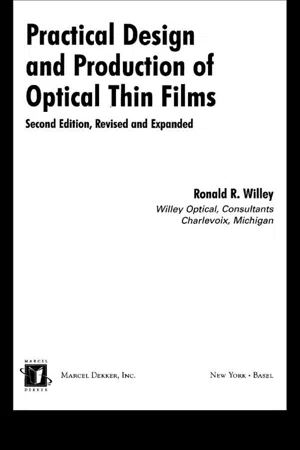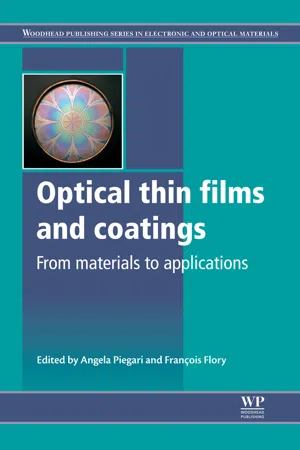Physics
Thickness Monitoring
Thickness monitoring involves the measurement and tracking of the thickness of a material, typically using specialized instruments or sensors. This process is important in various industrial and scientific applications, such as in semiconductor manufacturing, thin film deposition, and coating processes. By monitoring the thickness of materials, it is possible to ensure quality control and optimize production processes.
Written by Perlego with AI-assistance
Related key terms
Related key terms
1 of 4
Related key terms
1 of 3
3 Key excerpts on "Thickness Monitoring"
- Ronald R. Willey, Ronald R. Willey(Authors)
- 2002(Publication Date)
- CRC Press(Publisher)
Figure 7.1 is a simple flow chart of a typical thin film monitoring system. It consists of: defining the requirements, designing a plan of action to meet those requirements, the action of deposition of some thin film material, measurement of the properties of the deposited thin film, comparison of the results with the requirements, estimation of the next action needed, and feeding back this information to control the next action. The next action might be: to continue deposition, to stop because the goal has been achieved, or to stop because the goal is no longer achievable (failed process). In the case of most optical thin films, the requirements are in terms of reflectance and/or transmittance of a coated part at specific wavelengths. The action which attempts to meet these requirements is the application of some number of layers of material of appropriate index and absorptance with thicknesses that are designed to meet the requirements. It is necessary to be able to control these layer properties to within some tolerances determined by the requirements of the coating. In order to control the properties, it is necessary to measure the properties or something from which the properties can be derived. It is desirable to have some confidence at each step of the process that the requirements are still achievable and have not been made unattainable due to some uncompensatable error which has already occurred. Monitoring is a means to measure and know the status at a given point with sufficient accuracy to be able to exercise the necessary control (if possible) to get where we want to be. Thoeni1 also has an interesting discussion of process control in optical thin film fabrication.Fig. 7.1 . Flow chart of major elements of a typical thin film monitoring system.The purpose of this chapter is to discuss monitoring techniques which might be used to most efficiently allow requirements to be met. This ultimately relates to the yield of a given process and the fixed and operating costs of the equipment. We will not address these economic factors in detail here, but the economic motive underlies most of what we discuss. If it were not for economics, there could be a tendency to use the most precise and sophisticated process possible for even the simplest task. Another extreme is to use a process with inadequate control, and thereby have a yield which is so small or negligible that the product is prohibitively expensive.- eBook - ePub
- Charles Bishop(Author)
- 2011(Publication Date)
- William Andrew(Publisher)
It can be important to calibrate the system as moving the sample around to get the best image can sometimes lead to errors. The STEM requires samples that are thin enough to be transparent to the electrons. This usually requires the coated sample to be encased in a polymer and then thin slivers cut using a microtome. Again after suitable calibration a direct measurement of the coating thickness can be made. These direct measurement techniques have the advantage in that they measure the total coating thickness and are not affected by changes in stoichiometry. This is important for metallized coatings where the aluminum oxidizes both on the air surface and at the interface. When using eddy current or OD measurements, they measure only the conducting or opaque metal material and take no account of the insulating or transparent oxide component of the coating. Thus, any estimate of coating thickness using either the eddy current or OD techniques will not be accurate unless some conversion factor is included. This is covered in more detail in Chapter 16 (Section 16.5.3). 5.8.5. Quartz Crystal Monitor This monitoring technique uses a resonating quartz crystal placed into the deposition flux and as the crystal becomes coated the resonant frequency changes. The change in resonant frequency is related to the change in mass of the crystal, as the coating thickness increases and the stiffness of the thin quartz crystal is affected. As this technique uses a change in mass of the quartz crystal, it is sometimes referred to as a quartz crystal microbalance. This measurement of changing mass per unit time will allow a calculation of the number of atoms of the depositing material that must have been deposited, and as the coating area is known the thickness or deposition rate can be determined - eBook - ePub
Optical Thin Films and Coatings
From Materials to Applications
- Angela Piegari, François Flory(Authors)
- 2013(Publication Date)
- Woodhead Publishing(Publisher)
Quartz crystal monitoring of thin film coating production is also widely employed in the case of stable deposition processes (Macleod, 2001). Nevertheless the interest in optical monitoring strategies has been only increased with the new developments in deposition technologies. This is obviously connected to the fact that such strategies monitor optical thicknesses of coating layers and not their physical thicknesses. Macleod (1981) wrote that this had always been considered as a strong argument in support of optical monitoring strategies. Indeed, an attentive study of the basics of thin film theory shows that only thin film optical thicknesses are physically sensible and are entirely responsible for the optical properties of a coating (Furman and Tikhonravov, 1992). Optical monitoring of thin film coating production has almost been as long a history as thin film optics itself. Macleod (2001, p. 500) mentions the early paper devoted to this subject (Banning, 1947) where a table allowing the monitoring of film optical thickness in quarter wave units by a color of reflected light was presented. Practically all early works on optical monitoring were connected to the production of multilayers with quarter wave optical thicknesses of their layers. For such multilayers reflectance/transmittance is monitored at a central wavelength which is four times quarter wave optical thickness. A monitoring signal reaches its maxima or minima exactly at an instant when a new quarter wave portion of layer optical thickness is deposited. Monitoring of reflectance/transmittance extrema in early days of thin film optics was done by a vacuum plant operator and a 5% accuracy of layer Thickness Monitoring was typical for a trained operator (Macleod, 2002, p
Index pages curate the most relevant extracts from our library of academic textbooks. They’ve been created using an in-house natural language model (NLM), each adding context and meaning to key research topics.
Explore more topic indexes
Explore more topic indexes
1 of 6
Explore more topic indexes
1 of 4


